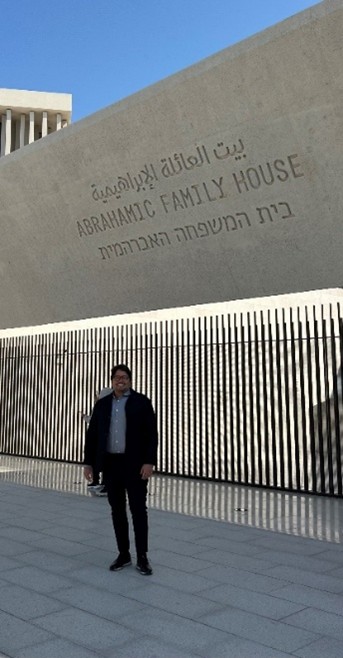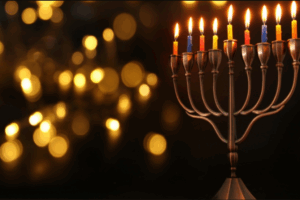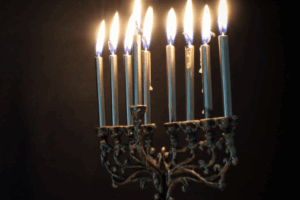Andy at Abrahamic Family House December, 2024
- What is a new place you have celebrated Shabbat? How did you feel in the new environment?
- How was it different? How was it familiar?
Saturday December 14, 2024, I celebrated Shabbat services in Abu Dhabi at the Abrahamic Family House.
The vision for the Abrahamic Family House originated after the signing of the Document on Human Fraternity by Pope Francis and Grand Imam Ahmed Al-Tayeb in February 2019. In 2020, the Abraham Peace Accords was led by the vision of President Trump and leaders of the UAE and Israel, with additional participation from Bahrain, Morocco, and Sudan. You can read more about the Abrahamic Family House here.
It was a truly transportive and inspiring experience. I would like to share my learnings from the day.
I arrived at the synagogue and met Rabbi Jeff. In an interesting coincidence, both Rabbi Jeff and I speak Japanese. Rabbi Jeff welcomed me in typical Japanese manner and I offered him a Breaking Matzo cookbook as an arrival omiyage (gift in Japanese)
I entered the synagogue and joined the service. I was the 10th man to attend so I was able to help make a minyan.
It was a special day because the Chief Rabbi of France, Haïm Korsia, was leading the service.
I announced to Rabbi Jeff that I am a Kohen, which meant the service could have special torah readings. Rabbi Jeff invited me to open the Ark and receive the torah. The torah used at the Abrahamic Center is from Yemen.
Due to the fact that there were no Levis present and that I am a Kohen, I received a two aliyas (being called to the Torah for a reading).
I chanted the torah blessings proudly and loudly. Rabbi Jeff whispered to me in Japanese where to stand. I stood behind Rabbi Korsia and watched intently as he read from the Yemenite torah. It truly felt like my second bar mitzvah!
Since my first trip to the UAE in 1999, I dreamed of the time when there would be peace between the UAE and Israel. After visiting the UAE every single year since 1999, I was so excited with the announcement of the Abraham Peace Accords on august 15, 2020.
For me, attending shabbat services at the Abrahamic Family House is yet another spiritual milestone in the expansion and evolution of peace.
I would like to share an idea that I explored as well as a feeling that I had.
In Leviticus 23, The Torah introduces the concept of Sacred Time by detailing the ritual calendar. (My daughter Caroline’s Haftorah Portion was Leviticus 23 and interpreted the torah so beautifully that day. Caroline discussed the significance of “making Holidays into Holydays”.)
In the book The Sabbath, Abraham Joshual Heschel talks about Shabbat being a temple of time and not a temple of space.
When I was in the synagogue in Abu Dhabi, I was in a new physical location. Nevertheless, it felt so familiar because of the special feeling of Shabbat: the prayers, reading the torah, the feeling of being part of a minyan. I truly felt the warmth of Shabbat’s sacred time as opposed to feeling detached from my familiar spaces for Jewish prayer.
I also reflected on the countless times that I had discussed and debated the concept of “Peace in the Middle East” and the ability for Israel and the UAE, Bahrain, and other Gulf countries to co-exist. Leading peace missions was so fulfilling to observe and enable my Emirati and Israeli friends to meet, discuss feelings and ideas that they previously were not able to do.
However, being in the Abrahamic Family House was truly a memorable mitzvah. I was overwhelmed with the true meaning of peace… Not just for countries to exchange people and products for prosperity…Not just to be at peace and free of potential military conflict. In addition, I personally felt freedom of spiritual access and expression. I was truly free to celebrate Shabbat as a Jew, with my fellow Jews, from around the world in complete harmony.
It was particularly appropriate that that Torah Portion was Genesis 33 (Vayishlach).
Genesis 33 has two powerful themes: Struggle and Forgiveness. Jacob wrestling with an angel, hurting his hip, and receiving the new name of Israel, “He who struggles with God and survives” The second theme of forgiveness is when Jacob and Esau reconcile their life long feud and differences.
Both of these themes, Struggle and Forgiveness, are evident in the necessary human evolution to form the Abraham Peace Accords between Israel, UAE, and Bahrain…and consequently the Abrahamic Family House.
The Abrahamic Family House has three prayer locations in the same complex for Christians, Jews, and Muslims. This multi-faith building reminded me of the Tomb of Samuel located in Nabi Samwil which is an important pilgrimage site in Israel for Christians, Jews, and Muslims.
I connected with the visceral nature of the physical surroundings. The actual synagogue was so beautiful and clean in its lines and architecture. It felt familiar in the core design but local in its aesthetic. One of the design elements was to represent the concept of a Succah. I looked up to the sky and felt the Gulf sun shining down on our services and warming the room. The actual prayer books were so crisp, new, and clean. It is a rare feeling to have such new prayer books. My usual experience is that the pages are worn and used.
On that Saturday, I felt like an adventurer creating new paths in the spiritual desert sand with my footprints guiding the way to pray for future generations.
Background on Nabi Samwill/Tomb of Samuel
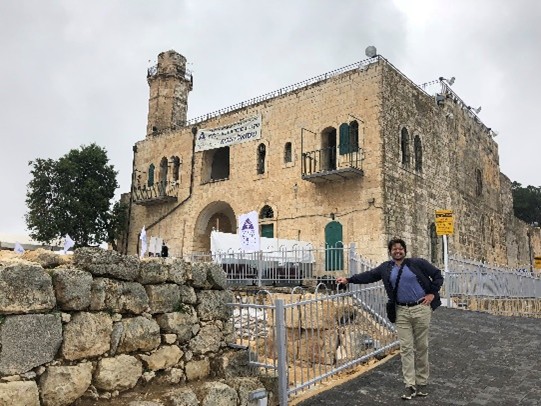
Andy visited Nabi Samwil on May 12, 2018

Andy visited Nabi Samwil June 10, 2019
Samuel was one of the more striking personalities of the Bible, ruling the Jewish people as a prophet during the time of the Judges and serving as the kingmaker of both King Saul and Saul’s successor, King David. According to a biblical tale, Samuel’s mother, Hannah, was bereft of children for many years, and gave birth to her only son only after she pledged to enlist him in the service of God at the Tabernacle in Shiloh.
Known as Nebi Samuel, the site traditionally recognized as Samuel’s grave is situated atop a steep hill to the north of the Jerusalem neighborhood of Ramot. The site contains an 18th-century mosque, built on the remains of a Crusader-era fortress; the tomb and a small synagogue are located in an underground chamber underneath the mosque. The Bible’s Book of Samuel states that the prophet was buried in his hometown of Rama, to the east of the site. But the 12th-century Jewish traveler, Benjamin MiTudela, tells us that the Crusaders have re-entered Samuel’s remains at the top of the hill overlooking Jerusalem.
Due to its elevation and strategic importance, the Tomb of Samuel has played host to several battles in the modern era. Although excavations have not unearthed remains from Samuel’s time, both Jewish and Muslim prayers are held regularly at the site, with many religious Jews visiting on the anniversary of Samuel’s death, the 28th of Iyar, in the springtime.
Update:
On May 15, 2025, as a demonstration of the commitment of UAE to the freedom for faith and worship, UAE Tolerance Minister Sheikh Nahyan bin Mubarak Al Nahyan guided President Trump on a tour of the Abrahamic Family House and the Moses Ben Maimon Synagogue. Here are some photos and videos of this historic visit
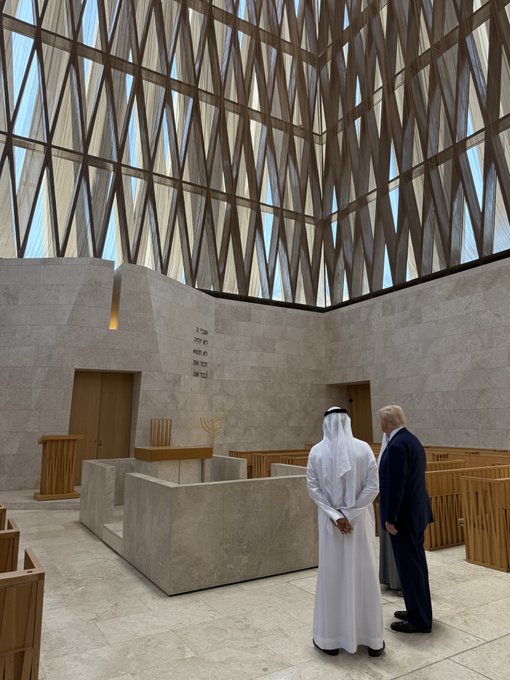
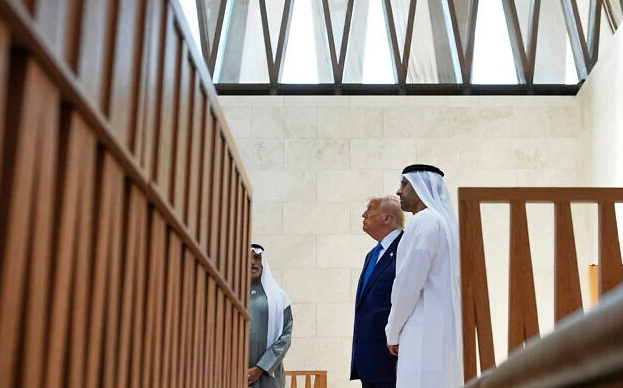
Appendix
Enjoy a haiku inspired by this blog:
Shabbat in the sand,
Kohen’s voice fills sacred space,
Peace blooms in the dunes

